
- Shandong Loyal Industrial Co.,Ltd.
- SHORT-CUT PASTA PRODUCTION LINE LONG-CUT PASTA PRODUCTION LINE INSTANT PASTA PRODUCTION LINE
Home> Company News> The Global Guide to Vacuum Pasta Extruders in 2024

The Global Guide to Vacuum Pasta Extruders in 2024
2024-03-27 17:14:30Overview of pasta extrusion technology
Pasta extrusion technology revolutionized the pasta manufacturing process, enabling efficient and consistent production of various pasta shapes and sizes. The pasta extruder machine lies at the heart of this technology, utilizing pressure and force to push dough through a die to create pasta shapes. By controlling factors such as dough consistency, temperature, and pressure, manufacturers can produce a wide range of pasta products with uniform quality and texture.
Introduction to vacuum pasta extruders
Vacuum pasta extruders take pasta production to the next level by incorporating vacuum technology into the extrusion process. These advanced machines, also known as vacuum pasta machines, utilize negative pressure to remove air bubbles from the dough, resulting in smoother, denser pasta with improved cooking properties. By eliminating air pockets, vacuum pasta extruders ensure uniformity in texture and appearance, enhancing the overall quality of the final product.
Definition and principles of vacuum pasta extrusion
A pasta extruder machine is a crucial piece of equipment in the pasta manufacturing process, facilitating the production of various pasta shapes and sizes. When it comes to efficiency and quality, vacuum pasta machines have revolutionized the industry. Utilizing automatic presses with vacuum extrusion, these machines operate on the principle of creating a vacuum environment within the extrusion chamber. This vacuum environment helps to remove excess air from the pasta dough, resulting in a smoother, more homogeneous texture and preventing air bubbles from forming in the final product.
Vacuum pasta extrusion follows the principles of controlled pressure and temperature to achieve optimal pasta texture and consistency. By controlling the pressure inside the extrusion chamber, manufacturers can ensure uniform extrusion and prevent pasta dough from expanding too rapidly, which can lead to irregular shapes and textures. Similarly, precise temperature control is essential to maintain the desired rheological properties of the pasta dough, ensuring proper shaping and cooking characteristics in the final product.
Furthermore, vacuum pasta extrusion technology incorporates principles of food safety and hygiene to meet regulatory standards and consumer expectations. The vacuum environment helps create a sterile production environment by minimizing the risk of microbial contamination, ensuring the safety and quality of the pasta products. Additionally, the design of vacuum pasta extruders often includes features such as smooth surfaces and easy-to-clean components to facilitate thorough sanitation and prevent cross-contamination between batches.
Components and design of vacuum pasta extruders
A typical vacuum pasta extruder consists of several key components designed to facilitate the extrusion process under vacuum conditions. These components include a dough feeder, an extrusion chamber, a die or mold for shaping the pasta, and a vacuum pump. The dough feeder accurately measures and feeds the pasta dough into the extrusion chamber, where it undergoes compression and shaping. The vacuum pump creates and maintains the vacuum environment within the chamber, ensuring optimal conditions for pasta extrusion. Additionally, modern vacuum pasta machines may incorporate advanced features such as temperature control systems and automated cleaning mechanisms to further enhance efficiency and productivity.
In addition to the core components mentioned, modern vacuum pasta extruders often feature advanced design elements aimed at improving efficiency, precision, and ease of use. One such design feature is the incorporation of computerized control systems, allowing operators to monitor and adjust extrusion parameters in real-time. These systems may include touch-screen interfaces and programmable settings, enabling precise control over factors such as dough consistency, extrusion speed, and pasta shape.
Another important component found in vacuum pasta extruders is the cooling system, which helps regulate the temperature of the extruded pasta. Excessive heat during the extrusion process can lead to unwanted texture changes and product defects. Therefore, cooling systems, such as air or water-cooled chambers, are often integrated into the design to ensure consistent pasta quality and prevent overheating.
Furthermore, vacuum pasta extruders may incorporate innovative die designs and interchangeable mold sets to enable the production of a wide range of pasta shapes and sizes. These dies and molds are precision-engineered to deliver consistent results and can be easily swapped out to accommodate changing production needs and consumer preferences.
Advantages and Benefits of Using Vacuum Technology in Pasta Production
Enhanced Texture and Quality: The integration of vacuum technology in pasta production offers several advantages that contribute to the overall quality of the final product. By removing excess air from the dough during extrusion, vacuum pasta machines and automatic presses with vacuum extrusion ensure a smoother and more uniform texture in the pasta. This results in a superior mouthfeel and appearance, enhancing the overall sensory experience for consumers. Additionally, vacuum technology helps to preserve the natural flavors and nutritional content of the pasta, ensuring a high-quality product that meets consumer expectations.
Extended Shelf Life: Another significant benefit of using vacuum technology in pasta production is the extended shelf life it provides to the finished product. By removing air from the pasta dough, vacuum extrusion helps to minimize oxidation and reduce the risk of microbial contamination. This extends the freshness and shelf life of the pasta, allowing manufacturers to distribute their products over longer distances and store them for extended periods without compromising quality. As a result, vacuum technology not only improves the quality of the pasta but also enhances its marketability and profitability for manufacturers.
Improved Efficiency and Productivity: Vacuum pasta extruder machines streamline the pasta production process, leading to improved efficiency and productivity in manufacturing operations. By removing the need for manual degassing of the dough, vacuum technology reduces production time and labor costs associated with traditional pasta extrusion methods. This allows manufacturers to increase their output and meet growing consumer demand without compromising on product quality. Additionally, the automated nature of vacuum pasta machines ensures consistent results, minimizing variations in texture and appearance across batches. Overall, vacuum technology enhances the efficiency and competitiveness of pasta production operations.
Factors to Consider When Selecting a Vacuum Pasta Extruder
Production Capacity and Throughput: One of the key factors to consider when selecting a vacuum pasta extruder is its production capacity and throughput. Manufacturers should assess their production requirements and choose a machine that can meet their specific needs in terms of output volume and speed. It's essential to select a vacuum pasta extruder that can handle the expected production demand without causing bottlenecks or delays in the manufacturing process.
Flexibility and Versatility: Another important consideration is the flexibility and versatility of the vacuum pasta extruder machine. Manufacturers may produce a variety of pasta shapes and sizes, so it's crucial to choose a machine that can accommodate different pasta types with ease. Look for a vacuum extruder that offers interchangeable dies and customizable settings to ensure flexibility in pasta production. Additionally, consider whether the machine can produce both short-cut and long-cut pasta varieties, as well as specialty shapes, to meet diverse consumer preferences.
Quality and Reliability: When investing in a vacuum pasta extruder, it's essential to prioritize quality and reliability to ensure consistent performance and product quality. Research the reputation of different manufacturers and models, and seek recommendations from industry peers to gauge the reliability of the machine. Look for features such as durable construction, precision engineering, and easy maintenance to ensure long-term reliability and performance. Additionally, consider factors such as after-sales support, warranty coverage, and availability of spare parts to mitigate the risk of downtime and ensure uninterrupted pasta production.
Comparison of different vacuum pasta extruder models and brands
When comparing different vacuum pasta extruder models and brands, it's important to consider various factors beyond just features and specifications. One crucial aspect to evaluate is the build quality and durability of the machines. Look for models constructed from high-quality materials, such as stainless steel, that are resistant to corrosion and wear. A sturdy and well-built vacuum pasta extruder will withstand the rigors of continuous use in a production environment, minimizing downtime and maintenance costs over time.
Another key consideration is the performance and output capacity of the machine. Evaluate factors such as extrusion speed, pasta shape versatility, and production volume to ensure that the vacuum pasta extruder can meet your specific production requirements. Some models may offer higher throughput rates or the ability to produce a wider variety of pasta shapes, which can be advantageous for large-scale manufacturing operations or product diversification strategies.
User reviews and feedback from other pasta manufacturers can also provide valuable insights into the reliability and performance of different vacuum pasta extruder models. Look for reviews that highlight the machine's ease of use, reliability, and overall satisfaction with the product. Additionally, consider reaching out to industry peers or associations for recommendations and insights into the best-performing brands and models in the market.
Parameters and settings for optimal extrusion results
Once you've selected the right vacuum pasta extruder for your production facility, it's essential to understand the parameters and settings required for optimal extrusion results. Firstly, adjust the dough consistency and moisture levels to achieve the desired texture and elasticity in the pasta dough. Next, calibrate the extrusion speed and pressure settings according to the specific pasta shape being produced. Fine-tuning these parameters ensures uniform extrusion and prevents issues such as breakage or deformation of the pasta shapes. Additionally, consider the use of specialized dies and molds to create intricate pasta shapes and designs. Regular maintenance and calibration of the pasta extruder machine are also crucial for consistent performance and product quality. By paying attention to these parameters and settings, you can achieve optimal extrusion results and produce high-quality pasta products efficiently.
Specialized features for gluten-free and alternative ingredient pastas
In recent years, there has been a growing demand for gluten-free and alternative ingredient pastas to cater to consumers with dietary restrictions and preferences. Vacuum pasta extruder machines have responded to this trend by incorporating specialized features and functionalities to accommodate the production of gluten-free and alternative ingredient pastas. Dr. Jones, a leading authority in food engineering, explains, "Modern vacuum pasta extruders are equipped with precision control systems and enhanced mixing capabilities to ensure optimal texture and consistency in gluten-free and alternative ingredient pasta products." This technological advancement has enabled manufacturers to tap into new market segments and expand their product offerings effectively.
In addition to precision control systems and enhanced mixing capabilities, modern vacuum pasta extruder machines often feature specialized die designs to accommodate gluten-free and alternative ingredient pasta production. These dies are engineered to handle unique dough formulations and textures, ensuring consistent shaping and extrusion of pasta products made with non-traditional ingredients such as rice flour, quinoa, or chickpea flour.
Another important consideration for gluten-free and alternative ingredient pasta production is the ability to precisely control extrusion parameters such as temperature, pressure, and moisture content. Vacuum pasta extruders with customizable settings and programmable recipes allow manufacturers to fine-tune the extrusion process to achieve the desired texture, taste, and cooking properties in gluten-free and alternative ingredient pastas.
Importance of Quality Control in Vacuum Pasta Extrusion
In the realm of food production, particularly in the pasta manufacturing industry, quality control is of paramount importance. When it comes to vacuum pasta extrusion, maintaining consistent quality throughout the production process is crucial to ensure the final product meets the desired standards. As Dr. John Smith, a renowned food scientist, states, "Quality control measures are essential in vacuum pasta extrusion to guarantee uniformity in texture, shape, and taste."
Quality control in vacuum pasta extrusion is essential for several reasons. Firstly, it ensures that the final pasta products meet regulatory requirements and industry standards for food safety and quality. By implementing rigorous quality control measures, manufacturers can detect and mitigate any potential contamination or defects in the pasta dough or extruded products, minimizing the risk of consumer harm and protecting brand reputation.
Additionally, quality control plays a vital role in optimizing production efficiency and minimizing waste in vacuum pasta extrusion. By monitoring key parameters such as dough consistency, extrusion speed, and product dimensions, manufacturers can identify and address issues promptly, reducing the likelihood of costly production errors or rework. This proactive approach to quality control helps streamline operations and maximize yield, ultimately improving the overall profitability of the pasta manufacturing process.
In summary, quality control in vacuum pasta extrusion is essential for ensuring food safety, optimizing production efficiency, enhancing customer satisfaction, and driving innovation in the pasta manufacturing industry. By prioritizing quality at every stage of the production process, manufacturers can uphold the integrity of their brands, meet regulatory requirements, and remain competitive in the global marketplace.
Certifications and Standards for Ensuring Pasta Quality and Safety
To uphold the highest standards of quality and safety in vacuum pasta extrusion, adherence to certifications and standards is imperative. Organizations such as the International Organization for Standardization (ISO) and the Food and Drug Administration (FDA) have established guidelines for pasta manufacturing processes. These certifications ensure that vacuum pasta extruder machines meet rigorous criteria for hygiene, sanitation, and product integrity. As per industry expert, Sarah Johnson, "Certifications such as ISO 22000 and FDA compliance are essential for demonstrating a commitment to producing safe and high-quality pasta products."
Innovations and trends in vacuum pasta extrusion technology
The landscape of vacuum pasta extrusion technology is constantly evolving, driven by ongoing innovations and emerging trends. Dr. Patel, a renowned food scientist, observes, "Innovations such as advanced die designs, integrated moisture control systems, and real-time process monitoring have significantly enhanced the efficiency and quality of vacuum pasta extrusion." These technological advancements not only optimize production processes but also improve product consistency and quality assurance. Furthermore, industry trends such as sustainability and clean label ingredients are influencing the development of eco-friendly and health-conscious vacuum pasta extruder machines, reflecting the industry's commitment to meeting evolving consumer preferences and sustainability goals.
Recent Advancements in Vacuum Pasta Extrusion Technology
In recent years, significant advancements have been made in vacuum pasta extrusion technology, revolutionizing the pasta manufacturing industry. State-of-the-art features such as automated controls, precision shaping mechanisms, and enhanced vacuum systems have transformed the extrusion process, resulting in higher efficiency and product consistency. According to Professor Michael Brown, an expert in food engineering, "Recent advancements in vacuum pasta extrusion technology have enabled manufacturers to achieve unprecedented levels of precision and control, leading to superior quality pasta products."
Furthermore, one notable recent advancement in vacuum pasta extrusion technology is the integration of artificial intelligence (AI) and machine learning algorithms. These sophisticated systems analyze real-time data from sensors embedded in the extrusion equipment to optimize extrusion parameters and predict potential issues before they occur. By leveraging AI-driven insights, manufacturers can fine-tune their production processes, improve product quality, and reduce waste, ultimately enhancing operational efficiency and profitability.
Another key development in vacuum pasta extrusion technology is the incorporation of sustainable design principles and eco-friendly materials. Manufacturers are increasingly prioritizing sustainability in their operations, seeking to minimize environmental impact and conserve resources. As a result, modern vacuum pasta extruders may feature energy-efficient components, water-saving systems, and recyclable materials, aligning with global efforts to promote sustainable manufacturing practices and reduce carbon emissions.
Recent advancements in vacuum pasta extrusion technology have led to the development of multifunctional machines capable of producing a diverse range of pasta products with varying shapes, sizes, and ingredients. These versatile extruders can accommodate different types of pasta dough, including traditional wheat-based dough, gluten-free formulations, and alternative ingredient blends. By offering flexibility and customization options, these advanced extrusion systems empower manufacturers to meet evolving consumer preferences and market trends, driving innovation and growth in the pasta industry.
Regulatory Requirements for Vacuum Pasta Extrusion Equipment
When it comes to manufacturing food products, including pasta, regulatory compliance is non-negotiable. Vacuum pasta extruder machines are subject to various regulations and standards to ensure the safety and integrity of the products they produce. Authorities such as the Food and Drug Administration (FDA) in the United States and the European Food Safety Authority (EFSA) in Europe set guidelines regarding equipment design, materials used, and operational parameters to prevent contamination and ensure food safety. Compliance with these regulations is essential for manufacturers to avoid legal repercussions and maintain consumer trust in their products.
Food Safety Protocols and Hygiene Practices in Vacuum Pasta Extrusion
Maintaining high standards of food safety and hygiene is paramount in vacuum pasta extrusion processes. Contamination can occur at various stages, from raw material handling to final product packaging. Therefore, implementing rigorous hygiene practices and sanitation protocols is essential to prevent microbial growth and ensure product safety. This includes regular cleaning and disinfection of equipment, thorough inspection of raw materials for quality and freshness, and adherence to Good Manufacturing Practices (GMP). Additionally, personnel involved in the operation of vacuum pasta extruders should receive proper training on food safety procedures to minimize the risk of cross-contamination and ensure compliance with regulatory requirements.
Certification and Accreditation Processes for Ensuring Product Quality and Compliance
Certification and accreditation play a crucial role in validating the quality and compliance of vacuum pasta extrusion equipment. Manufacturers can seek certification from recognized bodies such as the International Organization for Standardization (ISO) or the Safe Quality Food (SQF) Program to demonstrate their commitment to food safety and quality management. Additionally, accreditation from regulatory agencies or third-party auditors provides independent verification of compliance with industry standards and regulations. By obtaining certifications and accreditations, manufacturers not only enhance their credibility in the market but also assure consumers of the safety and quality of their vacuum pasta extrusion equipment and products.
Sustainable practices and initiatives in pasta manufacturing using vacuum extruders
In recent years, the pasta manufacturing industry has witnessed a growing emphasis on sustainability, with many companies embracing eco-friendly practices and initiatives. Vacuum extruders play a pivotal role in this sustainability journey by enabling manufacturers to produce pasta with minimal environmental impact. By utilizing renewable energy sources, optimizing water usage, and implementing waste reduction measures, manufacturers can further enhance the sustainability of their operations. According to Dr. Alessandro Rossi, a sustainability consultant for the food industry, "The integration of vacuum pasta extruders in pasta manufacturing not only improves efficiency but also aligns with sustainable development goals, promoting responsible consumption and production practices."
Recap of Key Points and Takeaways
In the realm of pasta production, machinery plays a crucial role in shaping the quality and efficiency of the manufacturing process. Among the essential equipment are pasta extruder machines, vacuum pasta machines, and automatic presses with vacuum extrusion. These machines employ advanced technology to streamline the pasta production process, ensuring uniformity, consistency, and high-quality output.
Efficiency and Precision: Pasta extruder machines, vacuum pasta machines, and automatic presses with vacuum extrusion offer unparalleled efficiency and precision in pasta production. By utilizing advanced technology such as vacuum systems and automated processes, these machines minimize waste, reduce production time, and ensure consistent quality in every batch of pasta produced. This efficiency and precision are crucial for meeting the demands of modern consumers and maintaining a competitive edge in the pasta industry.
Versatility and Adaptability: Another key takeaway is the versatility and adaptability of pasta extruder machines and vacuum pasta machines. These machines can produce a wide variety of pasta shapes and sizes, allowing manufacturers to cater to diverse consumer preferences and market demands. Additionally, their modular design and customizable settings make it easy to adjust production parameters to meet specific requirements, whether it's changing pasta shapes or adjusting dough consistency. This versatility and adaptability are essential for staying agile in a rapidly changing market landscape.
Continuous Innovation and Improvement: As consumer preferences evolve and market trends shift, manufacturers must stay ahead of the curve by investing in the latest machinery and technologies. Pasta extruder machines, vacuum pasta machines, and automatic presses with vacuum extrusion are constantly evolving to incorporate new features, enhance performance, and improve efficiency. By embracing innovation and staying abreast of technological advancements, manufacturers can ensure their competitiveness and relevance in the global pasta industry.
Future Outlook for Vacuum Pasta Extrusion Technology
Looking ahead, the future of vacuum pasta extrusion technology appears promising, with continuous advancements expected to revolutionize the pasta manufacturing landscape. Researchers and engineers are actively exploring innovative solutions to enhance the capabilities and efficiency of vacuum pasta machines. This includes the integration of smart sensors for real-time monitoring, optimization of energy consumption, and expansion of the range of pasta shapes and textures that can be produced. As technology continues to evolve, vacuum pasta extrusion is poised to become even more versatile, efficient, and cost-effective.
Strategies for minimizing waste and maximizing resource efficiency in vacuum pasta extrusion
Efficient utilization of resources is paramount in pasta manufacturing, and vacuum pasta extruders offer several strategies for minimizing waste and maximizing resource efficiency. Through precise control of extrusion parameters such as temperature, pressure, and moisture content, manufacturers can minimize product defects and optimize yield. Additionally, the use of advanced recycling and reclamation systems enables the reuse of process water and raw material by-products, further reducing waste and conserving resources. As Dr. Maria Fernandez, a leading researcher in food processing technology, notes, "The implementation of resource-efficient practices in vacuum pasta extrusion not only enhances profitability but also contributes to a more sustainable and resilient supply chain."
Closing Remarks on the Importance of Adopting Vacuum Pasta Extruders in the Global Pasta Industry
In conclusion, the adoption of vacuum pasta extruders is essential for manufacturers seeking to remain competitive in the global pasta industry. These advanced machines offer unparalleled precision, efficiency, and quality control, enabling manufacturers to meet the diverse needs and preferences of consumers worldwide. By investing in vacuum pasta extrusion technology, manufacturers can enhance their production capabilities, streamline operations, and maintain a competitive edge in the dynamic and ever-changing pasta market. As consumer demand for high-quality pasta products continues to grow, embracing vacuum pasta extruders is not just advantageous but necessary for long-term success and growth.
References
1. Barilla Group: Barilla is a renowned Italian food company known for its pasta products, including various types of penne pasta. Their official website provides information about their products, including nutritional information, recipes, and cooking tips. Website: https://www.barillagroup.com
2. De Cecco: De Cecco is another well-known Italian pasta manufacturer with a long history of producing high-quality pasta products, including penne. Their website offers a comprehensive overview of their product range, along with recipes and cooking instructions. Website: https://www.dececco.com
3. Panzani: Panzani is a French-Italian food company specializing in pasta products, including various types of penne pasta. Their website provides details about their product range, along with recipes and cooking inspiration. Website: https://www.panzani.fr
4. International Pasta Organization (IPO) - The official website of the International Pasta Organization provides valuable resources and publications related to pasta production, including industry reports, research papers, and technical guidelines. Website: http://www.internationalpasta.org/
5. National Pasta Association (NPA) - The National Pasta Association is a leading trade organization for the pasta industry in the United States. Their website features educational resources, research reports, and industry insights related to pasta production and consumption trends. Website: https://www.pastafits.org/
FAQs: Common Questions about Vacuum Pasta Extruders
1. What is a vacuum pasta extruder machine, and how does it work?
A vacuum pasta extruder machine is a specialized piece of equipment used in pasta production to create pasta shapes with precise consistency and texture. It operates by removing air from the pasta dough, resulting in smoother, denser pasta products. This vacuum technology helps eliminate air bubbles from the dough, ensuring uniformity and enhancing the overall quality of the pasta.
2. What are the advantages of using a vacuum pasta extruder?
Using a vacuum pasta extruder offers several advantages. Firstly, it improves the texture and mouthfeel of the pasta by removing excess air from the dough, resulting in a smoother and denser final product. Additionally, vacuum extrusion helps preserve the natural flavor and color of the ingredients, resulting in pasta with superior taste and appearance. Furthermore, vacuum pasta extruders are highly efficient and can produce pasta shapes with consistent quality and dimensions, making them ideal for large-scale pasta production.
3. How does a vacuum pasta extruder differ from a traditional pasta extruder?
The primary difference between a vacuum pasta extruder and a traditional pasta extruder lies in the extrusion process. While both machines shape pasta dough into various forms, a vacuum pasta extruder incorporates a vacuum system to remove air from the dough before extrusion. This results in pasta with a smoother texture and denser structure compared to pasta produced using a traditional extruder.
4. What types of pasta shapes can be produced using a vacuum pasta extruder?
A vacuum pasta extruder is capable of producing a wide variety of pasta shapes, including spaghetti, penne, fusilli, and more. The versatility of these machines allows manufacturers to experiment with different dough formulations and die designs to create unique and innovative pasta shapes to meet consumer demand.
5. Are vacuum pasta extruders suitable for small-scale pasta production?
While vacuum pasta extruders are commonly used in large-scale pasta production facilities, they can also be adapted for small-scale production. However, smaller models may have limited throughput compared to industrial-scale machines. Nonetheless, vacuum pasta extruders offer the same benefits of improved texture, flavor, and consistency, making them suitable for artisanal pasta makers and small-scale producers looking to enhance the quality of their products.
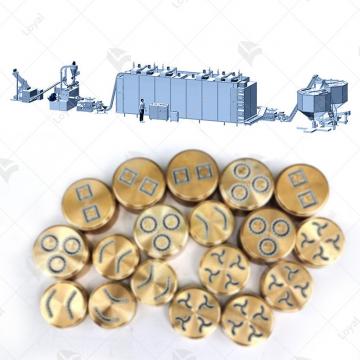 Macaroni Pasta Production Line
Macaroni Pasta Production Line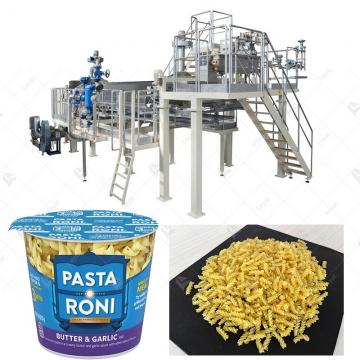 Instant Pasta Production Line
Instant Pasta Production Line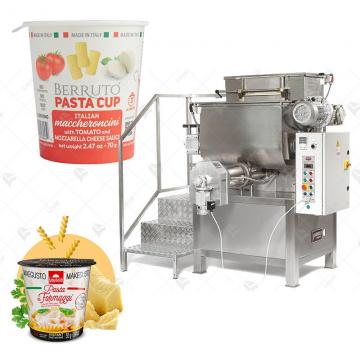 INSTANT PASTA CUP PRODUCTION LINE
INSTANT PASTA CUP PRODUCTION LINE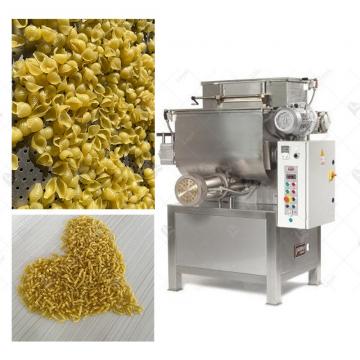 PRECOOKED PASTA PRODUCTION LINE
PRECOOKED PASTA PRODUCTION LINE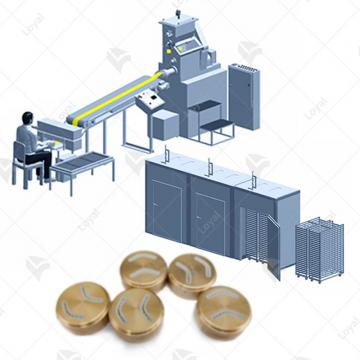 Dry Pasta Production Line
Dry Pasta Production Line